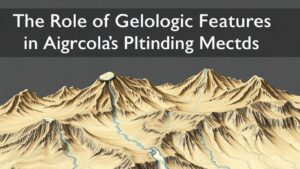The Use of Natural Rock Formations in Agricola’s Adit Construction Methods
The Use of Natural Rock Formations in Agricola’s Adit Construction Methods
In the realm of mining engineering, Georgius Agricola, a seminal figure of the 16th century, made significant advancements in understanding the principles of mineral extraction. His treatises laid a foundation for methodologies that included the clever use of natural rock formations in adit construction methods. This article explores Agricolas techniques, contextualizes them within the geological framework of his time, and highlights their enduring influence on contemporary mining practices.
Understanding Adit Construction
An adit is a horizontal or near-horizontal entrance to a mine, which serves as an access point for miners and equipment while facilitating the drainage of groundwater. Agricola recognized the strategic importance of leveraging the natural topography and geological features of the land to construct these entries efficiently. He analyzed various rock formations and geological layers to determine their stability and suitability for development.
Natural Rock Formations: A Geological Overview
Natural rock formations are diverse and can vary significantly in composition, structure, and mechanical properties. Agricolas work indicates that he categorized these formations into several types:
- Igneous Rocks: Formed from cooled molten material, these rocks usually exhibit high durability, making them suitable for supporting adit construction.
- Sedimentary Rocks: These layers, often softer and more porous, could present challenges in terms of stability but offered valuable resources, such as coal and iron.
- Metamorphic Rocks: Characterized by their crystalline structure, metamorphic rocks could provide insights into the geological history of the area, which Agricola utilized to predict mineral deposits.
Agricola’s Techniques in Leveraging Rock Formations
Agricola’s methodologies were innovative for their time, applying techniques that are still relevant in modern mining. For example:
- Geological Surveying: Agricola emphasized the need for thorough geological surveys prior to construction. By documenting the characteristics of the surrounding rock, he enabled miners to choose sites with favorable conditions, thus minimizing risks.
- Strategic Excavation: He favored excavating along natural fissures and seams in the rock, which facilitated access to mineral deposits and reduced the need for extensive tunneling.
- Drainage Systems: Natural gradients in the rock formations were utilized to design effective drainage systems, essential for preventing water accumulation within the mines.
Case Studies: Practical Application of Agricola’s Methods
One of the most illustrative examples of Agricola’s principles can be seen in the historic mining operations in the Erzgebirge Mountains of Central Europe. Miners during Agricola’s time employed adit systems that capitalized on the natural incline of the mountains, allowing for gravity-assisted drainage and efficient transport of mined resources.
Plus, in Germanys Harz Mountains, adits were developed following natural rock layers. This allowed miners to follow veins of silver while maintaining a safer working environment by utilizing the stable rock formations as structural supports.
Impact and Legacy
The methodologies proposed by Agricola not only influenced local mining practices but also set a precedent for future mining engineering standards. His work emphasized the importance of geology in determining mining feasibility, a principle that holds true today. As the modern mining industry continues to evolve, Agricolas foundational ideas provide a crucial link between the past and present practices of mineral extraction.
Conclusion and Actionable Takeaways
Agricola’s insights into the use of natural rock formations in adit construction demonstrate the importance of integrating geological understanding with practical mining operations. Today, mining engineers and geologists alike can benefit from reviewing Agricolas principles when designing modern adit systems. Key takeaways include:
- Conduct comprehensive geological surveys to inform site selection and excavation methods.
- Leverage natural features and rock characteristics to enhance structural integrity and operational efficiency.
- Use effective drainage strategies that utilize natural gradients to prevent water accumulation.
As we continue to draw lessons from historical practices, the integration of traditional knowledge with modern technology can lead to more sustainable and efficient mining operations.


